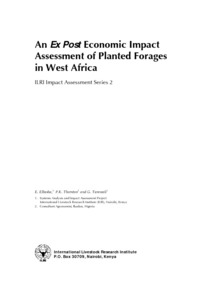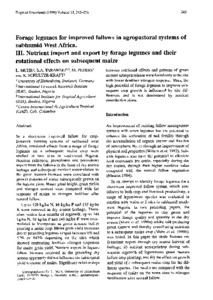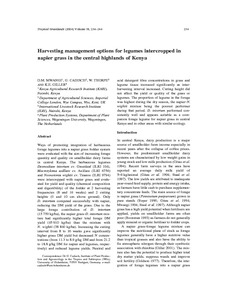Law on Pasture and Grazing Land.
This Law provides for the protection and use of pastures for cattle grazing.The Law identifies two kinds of pasture: specific pasture which exists within the boundaries of villages or towns; and communal pasture which is arid land and does not fall within the bounds of villages and towns. The right to use specific pasture may not be bought or sold, and it shall be forbidden to sell or lease it for expansion of agricultural activities.
Revisión sobre aspectos bioecológicos de especies del género Eryngium (Apiaceae)
p.269-279
From conflict to consensus: towards joint management of natural resources by pastoralists and agro-pastoralists in the zone of Kishi Beiga, Burkina Faso
This article explores the breakdown of complementarity between agriculture and livestock in the Kishi Beiga area in the north of Burkina Faso. The article suggests that the the two systems now compete for land and local management systems have broken down.This article discusses a joint GTZ and Government of Burkina Faso initiative to improve natural resource management and people's livelihoods.
The potential for rangeland development in Yak rearing areas of the Tibetan Plateau
This paper initially highlights the general characteristics of rangelands and pastoral production systems of the Tibetan Plateau.The article finds that:given the realities of life in a heterogeneous and marginal environment, the issue of secure resource tenure, both customary and legal, is fundamental for effective rangeland managementa simple shift in tenure from the communal (traditional and subsistence) to individual household level (ranching and commercial) will not be enough to facilitate a change in behaviour toward "rational" livestock operationsmany institutional mechanisms must be
Protest against the acquisition of common grazing land in Kadadara Panchayat, Gujarat
Local governance has become increasingly significant as devolution from central and provincial levels is being attempted in India as a result of the enactment of the 73rd and 74th Amendment of the Constitution in 1993. The essence of local self governance is to enable a small community to maintain access and control over their natural and physical resources, to take collective decisions in the common public good and to provide resources in priority developmental actions. Another dimension of local self governance is to demand accountability from people in public positions.
Who's managing the commons: inclusive mangement for a sustainable future
This article discusses what is the best means of managing the commons. The article stresses that these are critical questions in the current wave of decentralisation and tenure reform taking place in many Sahelian states.
Guidelines on the management of hilly and mountainous areas.
These guidelines contain principles of and rules for the management of hilly and mountainous areas. They define functions and duties of District Environment Committees and other local authorities in respect of management of hilly and mountainous areas duties of land owners in respect to use of grazing of livestock, cultivation, agroforestry and water run-off. Each District Council shall make bye-laws identifying mountainous and hilly areas within their jurisdiction which are at risk from environmental degradation.
An ex post economic assessment of planted forages in West Africa
This study assesses, in an indicative way, the impact of fodder banks and forage legume technology in countries of West Africa. The economic surplus method is used to estimate the social rate of return to public investment in research on fodder banks and the distribution of that return amongst producers and consumers. Subsequent sections of this report describe the technology of fodder banks, the economic surplus method, sources of data and the results of the analyses.
Ecoregional research at ILRI. Proceedings of a workshop
The major objectives of this workshop are to sharpen the focus of ILRI's ecoregional research, to further identify commonalities in tools and new methods that can enable ILRI to do effective transregional research, and to identify improvements to the way in which ILRI does ecoregional research.
Forage legumes for improved fallows in agropastoral systems of subhumid West Africa. I. Establishment, herbage yield and nutritive value of legumes as dry season forage
A short-term improved fallow system based on forage legumes is suggested for crop-livestock farming systems in subhumid West Africa targeted to enhance soil fertility and dry season feed for cattle. At two sites, 13 legume species were compared with the natural fallow vegetation, the nutritive value of which typically fails to meet cattle requirements during the dry season. Establishment, dry matter yield and nutritive value of leguminous herbage in the year of establishment were evaluated as well as regeneration of legumes after a cropping phase.
Forage legumes for improved fallows in agropastoral systems of subhumid West Africa. II. Green manure production and decomposition after incorporation into the soil
A short-term improved fallow system based on forage legumes for enhancing crop and livestock components of mixed farming systems was tested in the subhumid zone of West Africa. As part of the evaluation, the ability of 11 legume species (Centrosema macrocarpum, C. pubescens, Stylosanthes guianensis, Pueraria phaseoloides, Mucuna pruriens, Zornia glabra, Dioclea guianensis, Arachis pintoi, Aeschynomene histrix, Calopogonium caeruleum, Flemingia macrophylla) to accumulate biomass and nitrogen after dry season harvest of herbage was assessed at 2 sites in south-west Nigeria.







